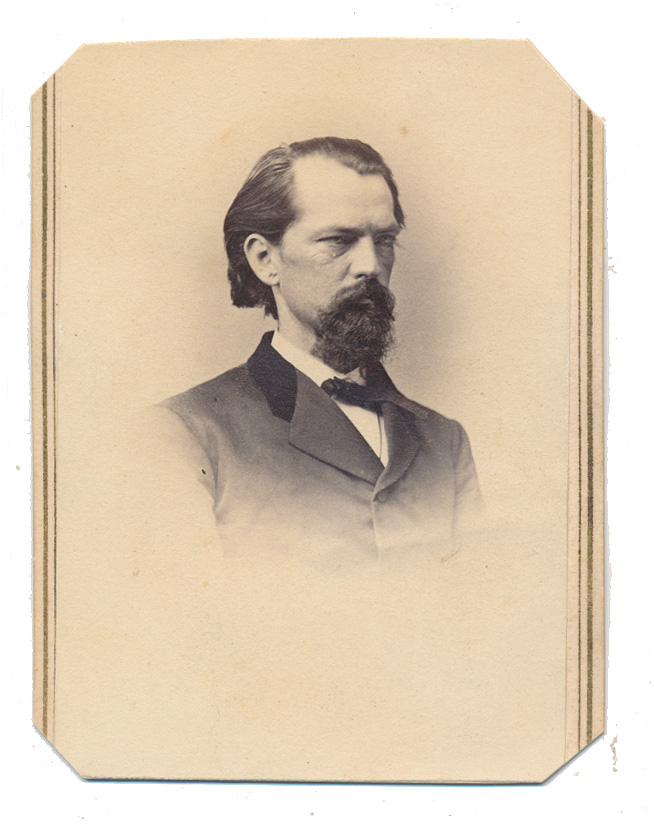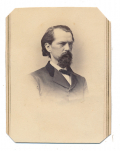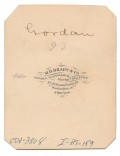site search
online catalog
CDV OF C.S. GENERAL JOHN B. GORDON

$175.00 SOLD
Quantity Available: None
Item Code: 1138-159
Bust view of Gordon in civilian clothes. Image is clear with very good contrast. The mount has been trimmed. Photographer’s backmark, M.B. Brady, Washington, DC & New York.
John Brown Gordon (February 6, 1832 – January 9, 1904) was an attorney, a slaveholding plantation owner, general in the Confederate States Army, and politician in the postwar years. By the end of the Civil War, he had become "one of Robert E. Lee's most trusted generals."
Although lacking military education or experience, Gordon was elected captain of a company of the 6th Alabama Infantry Regiment. Gordon's first combat experience happened at Seven Pines. Towards the end of the two-day battle, Gordon would take over as brigade commander when the Rodes was wounded.
At Antietam, in the vital sunken road, or "Bloody Lane", Gordon was wounded several times. First, a Minié ball passed through his calf. A second ball hit him higher in the same leg. A third ball went through his left arm. Gordon continued to lead his men. A fourth ball hit him in his shoulder. Ignoring pleas that he go to the rear, Gordon remained on the front lines. He was finally stopped by a ball that hit him in the face, passing through his left cheek and out his jaw. He was returned to Virginia and was nursed back to health by his wife.
Lee, impressed with Gordon's services, requested a promotion to brigadier general. During the Confederate invasion of Pennsylvania, Gordon's brigade occupied Wrightsville on the Susquehanna River, the farthest east in Pennsylvania any organized Confederate troops would reach. At the Battle of Gettysburg on July 1, Gordon's brigade smashed into the XI Corps on Barlow's Knoll.
Gordon left with Early for the Valley Campaigns of 1864, participating in the Battle of Lynchburg and in Early's Invasion of Maryland at the Battle of Monocacy before being wounded August 25, 1864, at Shepherdstown. Gordon continued to lead a division in Early's Army of the Valley, fighting at the Battle of Fisher's Hill and at the Battle of Cedar Creek.
Returning to Lee's army around Richmond after Early's defeat at the Cedar Creek, Gordon led the Second Corps of the Army of Northern Virginia until the end of the war. In this role, he defended the line in the Siege of Petersburg and commanded the attack on Fort Stedman on March 25, 1865, where he was wounded again, in the leg.
General Gordon was the first Commander-in-Chief of the United Confederate Veterans when the group was organized in 1890 and held this position until his death. He died while visiting his son in Miami, Florida, at the age of 71, and was buried in Oakland Cemetery in Atlanta, Georgia. [jet] [ph:L]
~~~~~~~~~~~~~~~~~~~~~~~~~~~~~~~~~~~
THIS ITEM, AS WITH ALL OTHER ITEMS AVAILABLE ON OUR WEB SITE,
MAY BE PURCHASED THROUGH OUR LAYAWAY PROGRAM.
CLICK HERE FOR OUR POLICIES AND TERMS.
THANK YOU!
Inquire About CDV OF C.S. GENERAL JOHN B. GORDON
For inquiries, please email us at [email protected]
Most Popular
Historical Firearms Stolen From The National Civil War Museum In Harrisburg, Pa »
Theft From Gravesite Of Gen. John Reynolds »
Selection Of Unframed Prints By Don Troiani »
Fine Condition Brass Infantry Bugle Insignia »
Wonderful Condition Original Confederate-Manufactured Kepi For A Drummer Boy Or Child »
featured item
RARE IDENTIFIED 65th NY SERGEANT’S JACKET, WITH MANSCRIPT MATERIAL: 1st U.S. CHASSEURS
This is an extremely rare, early-war uniform jacket, with related material, belonging to a sergeant of the 65th New York, who enlisted at the beginning of the war as the regiment’s commissary sergeant, and gained a lieutenant’s commission in a… (1179-233). Learn More »
site search
Upcoming Events
The shop is closed Jan. 2nd thru Jan. 16th for inventory; we will still be available by phone &… Learn More »




